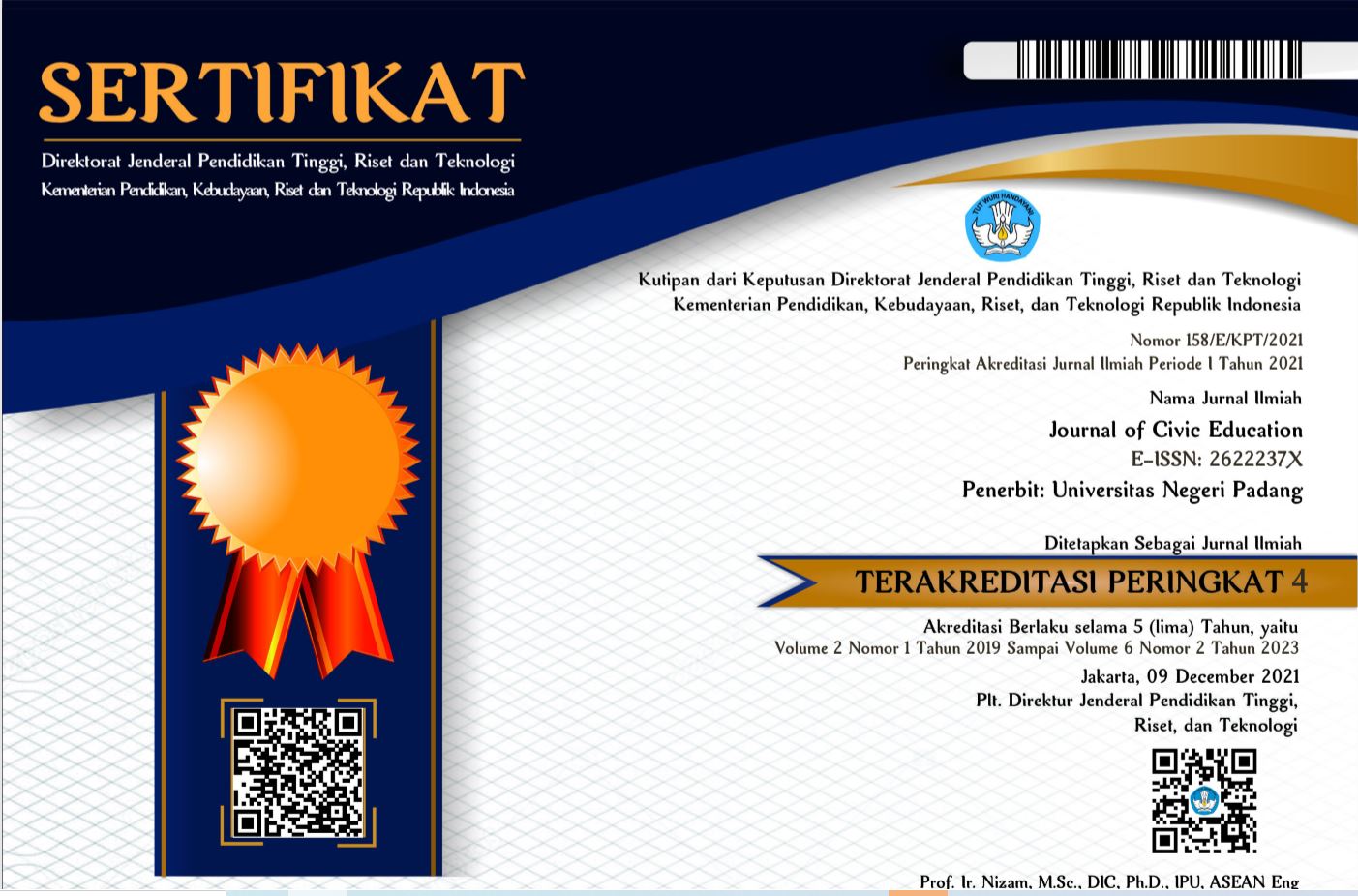Evaluasi Kebijakan Pengurangan Resiko Bencana di Kabupaten Pasaman
Abstract
The purpose of this study is to explain the evaluation of disaster management policies in the Pasaman regency. William N Dunn's criteria theory assessment is used in this qualitative descriptive study. The data-gathering methods used were observation, interviews, and documentation. The data analysis strategies are data reduction, data presentation, conclusions, and verification. The findings of this study shows that the objectives of Pasaman Regency's disaster risk reduction strategy have not been met and must be evaluated due to the suboptimal execution of disaster risk reduction activities. The effectiveness instrument revealed that actions, such as drafting contingency plans, had not been implemented, and the objectives of the disaster resistant village (Destana) and disaster awareness group (KSB) activities had not been met, resulting in this risk reduction policy not being enforced adequately. Next, a lack of human resources in terms of competence and funding has prevented various initiatives, such as the sustainability of Destana and KSB, from being implemented, failing to meet efficiency objectives. Next, the adequacy of Pasaman Regency's BPBD, such as the level of success of disaster risk reduction operations carried out, is deemed insufficient to address future issues. Then, it was discovered that the application of this policy did not create an even output in each Nagari that served as the study locus. In terms of the responsiveness of the implementation of the disaster risk reduction policy, which was carried out to elicit a positive response from the community, and finally, in terms of the accuracy of the implementation of this disaster risk reduction policy, it can be concluded that while it was right on target, it was not executed optimally.
References
Alazawi, Z., Alani, O., Abdljabar, M. B., Altowaijri, S., & Mehmood, R. (2014). A smart disaster management system for future cities. Proceedings of the 2014 ACM International Workshop on Wireless and Mobile Technologies for Smart Cities, 1–10.
Andreastuti, S. D., Paripurno, E. T., Subandriyo, S., Syahbana, D. K., & Prayoga, A. S. (2023). Volcano disaster risk management during crisis: implementation of risk communication in Indonesia. Journal of Applied Volcanology, 12(1), 3.
Chen, Y., He, S., & Zhou, Z. (2022). Investigation of social media representation bias in disasters: Towards a systematic framework. International Journal of Disaster Risk Reduction, 81, 103312.
Creswell, J. W. (2009). Research design: Qualitative, quantitative, and mixed methods approaches, 3rd ed. In Research design: Qualitative, quantitative, and mixed methods approaches, 3rd ed. Sage Publications, Inc.
Crosweller, M., & Tschakert, P. (2021). Disaster management and the need for a reinstated social contract of shared responsibility. In International Journal of Disaster Risk …. Elsevier. https://www.sciencedirect.com/science/article/pii/S2212420921004015
Dunn, W. N. (2015). Public policy analysis. books.google.com. https://books.google.com/books?hl=en&lr=&id=lPE5CgAAQBAJ&oi=fnd&pg=PP1&dq=leadership+organization+policy+public+service+motivation+good+governance+capacity+building&ots=GtJ_0Sywl8&sig=u3VHGonD0bRVX2W1HET2uk-ZCfY
Gerber, B. J., & Robinson, S. E. (2009). Local government performance and the challenges of regional preparedness for disasters. Public Performance & Management Review, 32(3), 345–371.
Gianni, E., Tyrologou, P., Couto, N., Correia, V., Brondi, S., Panagiotaras, D., & Koukouzas, N. (2023). Natural hazard insurance: dissemination strategies using geological knowledge. Environment Systems and Decisions, 43(4), 680–692.
Mihardja, E. J., Alisjahbana, S., Agustini, P. M., Sari, D. A. P., & Pardede, T. S. (2023). Forest wellness tourism destination branding for supporting disaster mitigation: A case of Batur UNESCO Global Geopark, Bali. International Journal of Geoheritage and Parks, 11(1), 169–181.
Mizuno, T., Kojima, N., & Asano, S. (2021). The risk reduction effect of sediment production rate by understory coverage rate in granite area mountain forest. Scientific Reports, 11(1), 14415.
Nursyabani, N., Putera, R. E., & Kusdarini, K. (2020). Mitigasi bencana dalam peningkatan kewaspadaan terhadap ancaman gempa bumi di universitas andalas. Jurnal Ilmu Administrasi Negara ASIAN (Asosiasi Ilmuwan Administrasi Negara), 8(2), 81–90.
Putera, R. E. (2018). Mitigasi Pengurangan Risiko Bencana Gempa Bumi Dari Perspektif Implementasi Kebijakan. Tersedia Dari ZLibrary Database.
Putera, R. E., Nurasa, H., & Sugandi, Y. S. (2016). Synergizing stakeholders in reducing risk of earthquake and tsunami-disaster in the most vulnerable area. BISNIS & BIROKRASI: Jurnal Ilmu Administrasi Dan Organisasi, 23(3), 5.
Ramadhan, R., Marzuki, M., Suryanto, W., Sholihun, S., Yusnaini, H., & Muharsyah, R. (2024). Rainfall variability in Indonesia new capital associated with the Madden-Julian Oscillation and its contribution to flood events. Quaternary Science Advances, 13, 100163.
Roque, A., Wutich, A., Brewis, A., Beresford, M., Landes, L., Morales-Pate, O., Lucero, R., Jepson, W., Tsai, Y., & Hanemann, M. (2024). Community-based participant-observation (CBPO): A participatory method for ethnographic research. Field Methods, 36(1), 80–90.
Setyonugroho, G. A., & Maki, N. (2023). Policy implementation model review of the post-disaster housing reconstruction in Indonesia case study: Aceh, Yogyakarta, and Lombok. International Journal of Disaster Risk Reduction, 104181.
Sinatra, T., Nugroho, G. A., Cholianawati, N., Indrawati, A., Renggono, F., Yulihastin, E., Lestari, S., Ahmad, U. A., Widada, W., & Awaludin, A. (2023). Extreme precipitation over complex terrain using multiple remote sensing observation: A case study in the Great Bandung, Indonesia. Remote Sensing Applications: Society and Environment, 32, 101058.
Solorzano, J., Morante-Carballo, F., Montalvan-Burbano, N., Briones-Bitar, J., & Carrion-Mero, P. (2022). A systematic review of the relationship between geotechnics and disasters. Sustainability, 14(19), 12835.
Strauss, A., & Corbin, J. (2003). Dasar-Dasar Penelitian Kualitatif (M. terj. Shodiq (ed.)). Pustaka Pelajar.
Wahyuni, E. S., Putera, R. E., & Yoserizal, Y. (2020). Strategi Pemerintah Kota Padang Dalam Pengembangan Pariwisata Berbasis Mitigasi Bencana. Jurnal Pendidikan Ilmu Sosial, 30(1), 49–60.
Peraturan dan Kebijakan
Kerangka acuan kerja bidang pencegahan dan kesiapsiagaan tahun 2020 BPBD Kabupaten Pasaman.
Laporan kinerja instansi pemerintah (LAKIP) tahun 2023 BPBD Kabupaten Pasaman.
Laporan penyelenggaraan Pemerintah Daerah (LPPD) BPBD Kabupaten Pasaman tahun 2023.
Laporan rekap kejadian bencana alam 2018-2023 BPBD Kabupaten Pasaman.
Rencana penanggulangan bencana tahun 2023 BPBD Kabupaten Pasaman.
Rencana strategis tahun 2022-2026 BPBD Kabupaten Pasaman.
Peraturan Daerah Kabupaten Pasaman Nomor 4 Tahun 2018 tentang penanggulangan bencana.



